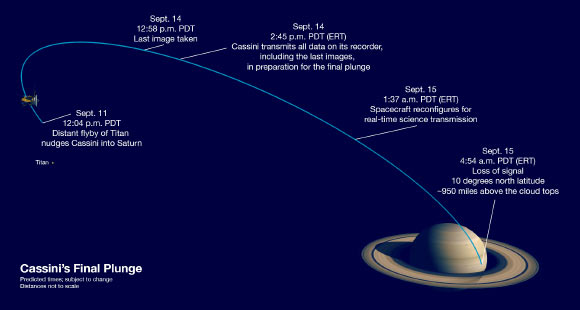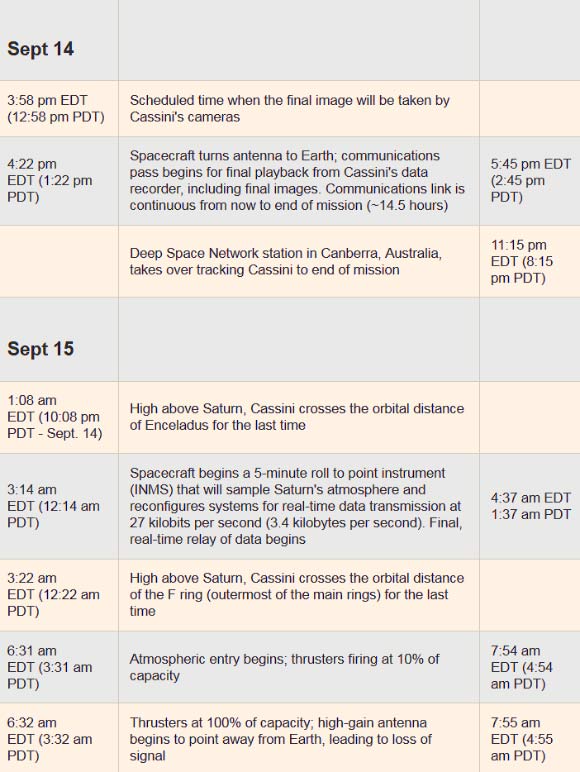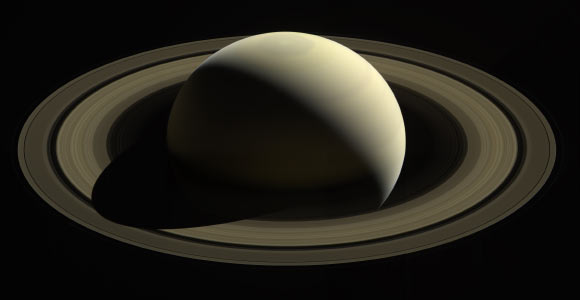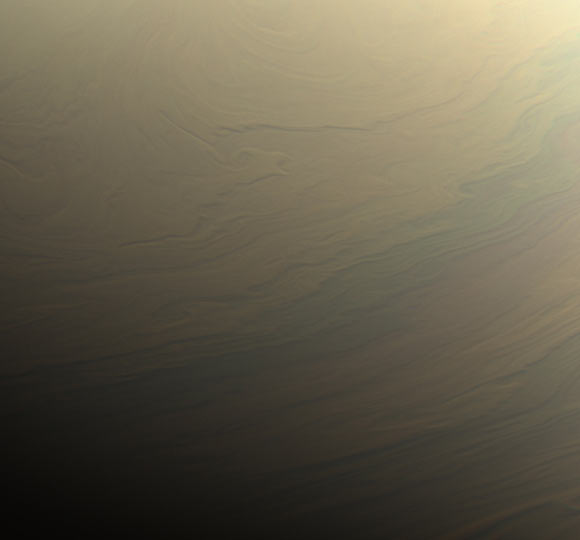On September 15, 2017, NASA’s Cassini spacecraft will make its final approach to Saturn, but this encounter will be like no other. This time, Cassini will dive into the planet’s atmosphere, sending science data for as long as its small thrusters can keep the probe’s antenna pointed at Earth. Soon after, Cassini will burn up and disintegrate like a meteor.

In this screenshot from the short animated film Cassini’s Grand Finale, the spacecraft is shown breaking apart after entering the atmosphere of Saturn. Image credit: NASA / JPL-Caltech.
Cassini is ending its 13-year tour of the Saturn system with an intentional plunge into the planet to ensure Saturn’s moons remain pristine for future exploration.
The spacecraft’s fateful dive is the final beat in the mission’s Grand Finale, 22 weekly dives, which began in late April, through the gap between Saturn and its rings.
“The Cassini mission is ending because, after two decades in space, its fuel is running out,” mission team members explained.
“To ensure a safe disposal of the spacecraft, and to avoid an unplanned impact onto pristine icy satellites such as ocean-bearing moon Enceladus, Cassini is being directed into the gas planet itself, where it will burn up.”
Because Saturn is so far from Earth, Cassini will have been gone for about 83 minutes by the time its final signal reaches NASA’s Deep Space Network station in Australia on September 15.
The current predicted time for loss of signal on Earth is 7:55 a.m. EDT (4:55 a.m. PDT, 11:55 a.m. GMT, 1:55 p.m. CEST). This time may change as Saturn’s atmosphere slows Cassini during each of the final orbits.
Cassini will enter Saturn’s atmosphere approximately one minute earlier, at an altitude of about 1,190 miles (1,915 km) above the planet’s cloud tops.
During its dive into the atmosphere, the spacecraft’s speed will be approximately 70,000 miles (113,000 km) per hour.
The final plunge will take place on the day side of Saturn, near local noon, with the spacecraft entering the atmosphere around 10 degrees north latitude.

Diagram of Cassini’s final week, showing some of the milestones as the spacecraft heads for its plunge into Saturn (times are predicted and subject to change). Image credit: NASA / JPL-Caltech.

Grand Finale timeline: times in left column are spacecraft event time, i.e., when the events happen at Saturn; times in right column for some entries are the time when the spacecraft’s signal relaying the event arrives on Earth; after events happen at Saturn, it takes 83 minutes for Cassini’s radio signal to reach Earth. Image credit: NASA / JPL-Caltech.
“The spacecraft’s final signal will be like an echo. It will radiate across the Solar System for nearly an hour and a half after Cassini itself has gone,” said Cassini project manager Dr. Earl Maize, of NASA’s Jet Propulsion Laboratory.
“Even though we’ll know that, at Saturn, Cassini has already met its fate, its mission isn’t truly over for us on Earth as long as we’re still receiving its signal.”
No images will be taken during the final plunge into Saturn, as the data transmission rate required to send images is too high and would prevent other high-value science data from being returned.
The final images will be taken on September 14 and are planned to include images of Titan, Enceladus, moonlet ‘Peggy’, a propeller feature in the rings and a color montage of Saturn and its rings, including the aurora at the north pole.
Cassini’s eight instruments (CDA, CIRS, INMS, MAG, MIMI, RPWS, RSS, UVIS) will collect data during the final plunge, transmitting it back to Earth in near-real time.

With this view, Cassini captured one of its last looks at Saturn and its main rings from a distance. Images taken on October 28, 2016 with Cassini’s wide angle camera using red, green and blue spectral filters were combined to create this color view. This view looks toward the sunlit side of the rings from about 25 degrees above the ringplane. The view was acquired at a distance of approximately 870,000 miles (1.4 million km) from Saturn. Image credit: NASA / JPL-Caltech / Space Science Institute.

Cassini gazed toward the northern hemisphere of Saturn to spy subtle, multi-hued bands in the clouds there. This view looks toward the terminator — the dividing line between night and day — at lower left. The Sun shines at low angles along this boundary, in places highlighting vertical structure in the clouds. Some vertical relief is apparent in this view, with higher clouds casting shadows over those at lower altitude. Images taken with the Cassini spacecraft narrow-angle camera using red, green and blue spectral filters were combined to create this natural-color view. The images were acquired on August 31, 2017, at a distance of approximately 700,000 miles (1.1 million km) from Saturn. Image credit: NASA / JPL-Caltech / Space Science Institute.
Here’s when to follow events broadcast by NASA via https://www.nasa.gov/nasalive
- September 14, 4 p.m. EDT (1 p.m. PDT, 8 p.m. GMT, 10 p.m. CEST): Cassini NASA Social from NASA’s Jet Propulsion Laboratory; this series of Q&A sessions with scientists and engineers behind the Cassini mission will also answer #askNASA questions submitted online.
- September 14, 11 p.m. EDT (8 p.m. PDT, 3 a.m. GMT on September 15, 5 a.m. CEST on September 15): final images expected to begin appearing online in Cassini raw image gallery.
- September 15, 7-8:30 a.m. EDT (4-5:30 a.m. PDT, 11 a.m.-12:30 p.m. GMT, 1-2:30 p.m. CEST): Cassini mission’s ‘Grand Finale;’ live commentary on NASA TV and online; an uninterrupted, clean feed of cameras from the NASA Jet Propulsion Laboratory’s Mission Control, with mission audio only, will be available on the NASA TV Media Channel and on Ustream.
- September 15, 9:30 a.m. EDT (6:30 a.m. PDT, 1:30 p.m. GMT, 3:30 p.m. CEST): Cassini post-mission news conference from NASA’s Jet Propulsion Laboratory.
The latest mission status reports from NASA are provided here.







